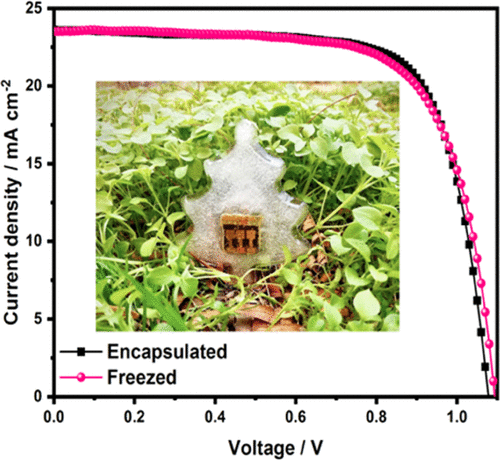当前位置:
X-MOL 学术
›
ACS Appl. Mater. Interfaces
›
论文详情
Our official English website, www.x-mol.net, welcomes your feedback! (Note: you will need to create a separate account there.)
Encapsulation Strategies for Highly Stable Perovskite Solar Cells under Severe Stress Testing: Damp Heat, Freezing, and Outdoor Illumination Conditions
ACS Applied Materials & Interfaces ( IF 9.5 ) Pub Date : 2021-09-16 , DOI: 10.1021/acsami.1c11628 Mahdi Mohammadi 1 , Somayeh Gholipour 2 , Mahdi Malekshahi Byranvand 3, 4 , Yaser Abdi 2 , Nima Taghavinia 1 , Michael Saliba 3, 4
ACS Applied Materials & Interfaces ( IF 9.5 ) Pub Date : 2021-09-16 , DOI: 10.1021/acsami.1c11628 Mahdi Mohammadi 1 , Somayeh Gholipour 2 , Mahdi Malekshahi Byranvand 3, 4 , Yaser Abdi 2 , Nima Taghavinia 1 , Michael Saliba 3, 4
Affiliation

|
A key direction toward managing extrinsic instabilities in perovskite solar cells (PSCs) is encapsulation. Thus, a suitable sealing layer is required for an efficient device encapsulation, preventing moisture and oxygen ingression into the perovskite layer. In this work, a solution-based, low-cost, and commercially available bilayer structure of poly(methyl methacrylate)/styrene-butadiene (PMMA/SB) is investigated for PSCs encapsulation. Encapsulated devices retained 80% of the initial power conversion efficiency (PCE) at 85 °C temperature and 85% relative humidity after 100 h, while reference devices without SB (only PMMA) suffer from rapid and intense degradation after only 2 h, under the same condition. In addition, encapsulated devices retained 95% of the initial PCE under −15 °C freezing temperature after 6 h and retained ∼80% of the initial PCE after immersion in HCl (37%) for 90 min. Moreover, applying an additional aluminum metal sheet on the PMMA/SB protective bilayer leads to the improvement of device stability up to 500 h under outdoor illumination, retaining almost 90% of the initial PCE. Considering the urge to develop reliable, scalable, and simple encapsulation for future large-area PSCs, this work establishes solution-based bilayer encapsulation, which is applicable for flexible solar modules as well as other optoelectronic devices such as light-emitting devices and photodetectors.improvement of device stability up to 500 h under outdoor illumination, retaining almost 90% of the initial PCE. Considering the urge to develop reliable, scalable, and simple encapsulation for future large-area PSCs, this work establishes solution-based bilayer encapsulation, which is applicable for flexible solar modules as well as other optoelectronic devices such as light-emitting devices and photodetectors.
中文翻译:

严重应力测试下高稳定性钙钛矿太阳能电池的封装策略:湿热、冷冻和室外照明条件
管理钙钛矿太阳能电池 (PSC) 外在不稳定性的一个关键方向是封装。因此,有效的器件封装需要合适的密封层,以防止水分和氧气进入钙钛矿层。在这项工作中,研究了一种基于溶液、低成本和市售的聚(甲基丙烯酸甲酯)/苯乙烯-丁二烯(PMMA/SB)双层结构用于 PSC 封装。在 85 °C 温度和 85% 相对湿度下,封装器件在 100 小时后保持了 80% 的初始功率转换效率 (PCE),而没有 SB(仅 PMMA)的参考器件仅在 2 小时后就遭受了快速而剧烈的退化。相同的条件。此外,封装的器件在 -15°C 冷冻温度下 6 小时后保留了初始 PCE 的 95%,并在浸入 HCl(37%)中 90 分钟后保留了初始 PCE 的约 80%。此外,在 PMMA/SB 保护双层上应用额外的铝金属片可将设备稳定性提高至室外光照下长达 500 小时,保留几乎 90% 的初始 PCE。考虑到为未来的大面积 PSC 开发可靠、可扩展和简单的封装的迫切需要,这项工作建立了基于溶液的双层封装,适用于柔性太阳能模块以及其他光电器件,如发光器件和光电探测器。在室外光照下,设备稳定性提高了 500 小时,几乎保持了初始 PCE 的 90%。考虑到开发可靠、可扩展、
更新日期:2021-09-29
中文翻译:

严重应力测试下高稳定性钙钛矿太阳能电池的封装策略:湿热、冷冻和室外照明条件
管理钙钛矿太阳能电池 (PSC) 外在不稳定性的一个关键方向是封装。因此,有效的器件封装需要合适的密封层,以防止水分和氧气进入钙钛矿层。在这项工作中,研究了一种基于溶液、低成本和市售的聚(甲基丙烯酸甲酯)/苯乙烯-丁二烯(PMMA/SB)双层结构用于 PSC 封装。在 85 °C 温度和 85% 相对湿度下,封装器件在 100 小时后保持了 80% 的初始功率转换效率 (PCE),而没有 SB(仅 PMMA)的参考器件仅在 2 小时后就遭受了快速而剧烈的退化。相同的条件。此外,封装的器件在 -15°C 冷冻温度下 6 小时后保留了初始 PCE 的 95%,并在浸入 HCl(37%)中 90 分钟后保留了初始 PCE 的约 80%。此外,在 PMMA/SB 保护双层上应用额外的铝金属片可将设备稳定性提高至室外光照下长达 500 小时,保留几乎 90% 的初始 PCE。考虑到为未来的大面积 PSC 开发可靠、可扩展和简单的封装的迫切需要,这项工作建立了基于溶液的双层封装,适用于柔性太阳能模块以及其他光电器件,如发光器件和光电探测器。在室外光照下,设备稳定性提高了 500 小时,几乎保持了初始 PCE 的 90%。考虑到开发可靠、可扩展、


























 京公网安备 11010802027423号
京公网安备 11010802027423号